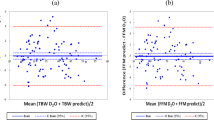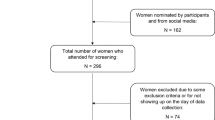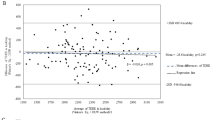Abstract
Objectives: To test the impact of body build factors on the validity of impedance-based body composition predictions across (ethnic) population groups and to study the suitability of segmental impedance measurements.
Design: Cross-sectional observational study.
Settings: Ministry of Health and School of Physical Education, Nanyang Technological University, Singapore.
Subjects: A total of 291 female and male Chinese, Malays and Indian Singaporeans, aged 18–69, body mass index (BMI) 16.0–40.2 kg/ m2.
Methods: Anthropometric parameters were measured in addition to impedance (100 kHz) of the total body, arms and legs. Impedance indexes were calculated as height2/impedance. Arm length (span) and leg length (sitting height), wrist and knee width were measured from which body build indices were calculated. Total body water (TBW) was measured using deuterium oxide dilution. Extra cellular water (ECW) was measured using bromide dilution. Body fat percentage was determined using a chemical four-compartment model.
Results: The bias of TBW predicted from total body impedance index (bias: measured minus predicted TBW) was different among the three ethnic groups, TBW being significantly underestimated in Indians compared to Chinese and Malays. This bias was found to be dependent on body water distribution (ECW/TBW) and parameters of body build, mainly relative (to height) arm length. After correcting for differences in body water distribution and body build parameters the differences in bias across the ethnic groups disappeared. The impedance index using total body impedance was better correlated with TBW than the impedance index of arm or leg impedance, even after corrections for body build parameters.
Conclusions: The study shows that ethnic-specific bias of impedance-based prediction formulas for body composition is due mainly to differences in body build among the ethnic groups. This means that the use of ‘general’ prediction equations across different (ethnic) population groups without prior testing of their validity should be avoided. Total body impedance has higher predictive value than segmental impedance.
This is a preview of subscription content, access via your institution
Access options
Subscribe to this journal
Receive 12 print issues and online access
$259.00 per year
only $21.58 per issue
Buy this article
- Purchase on Springer Link
- Instant access to full article PDF
Prices may be subject to local taxes which are calculated during checkout
Similar content being viewed by others
References
Baumgartner RN, Chumlea WC & Roche AF . 1989 Estimation of body composition from bioelectrical impedance of body segments Am. J. Clin. Nutr. 50: 221–226
Baumgartner RN, Heymsfield SB, Lichtman SM, Wang J & Pierson RN Jr . 1991 Body composition in elderly people: effect of criterion estimates on predictive equations Am. J. Clin. Nutr. 53: 1345–1353
Behnke AR, Feen BG & Welham WC . 1942 The specific gravidity of healthy men: body weight and volume as an index of obesity J.A.M.A. 188: 495–498
Dempster P & Aitkens S . 1995 A new air displacement method for the determination of human body composition Med. Sci. Sports Exerc. 27: 419–425
Deurenberg P . 1992 The Assessment of Body Composition: Uses and Misuses Annual Report 1992 Lausanne: Nestlé Foundation
Deurenberg P & Deurenberg-Yap M . 2001 Validation of skinfold thickness and hand-held impedance measurements for estimation of body fat percentage among Singaporean Chinese, Malays and Indians Asia Pacific J. Clin. Nutr. (in press).
Deurenberg P, van der Kooy K, Leenen R & Schouten FJM . 1989 Body impedance is largely dependent on the intra and extra cellular water distribution Eur. J. Clin. Nutr. 43: 845–853
Deurenberg P, Tagliabue A & Schouten FJM . 1995 Multi-frequency impedance for the prediction of extra-cellular water and total body water Br. J. Nutr. 73: 349–358
Deurenberg P, Deurenberg-Yap M, Wang J, Lin Fu Po & Schmidt G . 1999 The impact of body build on the relationship between body mass index and body fat percent Int. J. Obes. Relat. Metab. Disord. 23: 537–542
Deurenberg-Yap M, Schmidt G, Staveren WA & Deurenberg P . 2000 The paradox of low body mass index and high body fat percent among Chinese, Malays and Indians in Singapore Int. J. Obes. Relat. Metab. Disord. 24: 1011–1017
Eveleth PB & Tanner JM . 1976 World-wide Variation in Human Growth Cambridge: Cambridge University Press
Forbes GB . 1987 Human Body Composition New York: Springer
Fuller NJ & Elia M . 1989 Potential use of bioelectrical impedance of the ‘whole body’ and of body segments for the assessment of body composition: comparison with densitometry and anthropometry Eur. J. Clin. Nutr. 43: 779–791
Guricci S, Hartriyanti Y, Hautvast JGAJ & Deurenberg P . 1999a Differences in the relationship between body fat and body mass index between two different Indonesian ethnic groups: the effect of body build Eur. J. Clin. Nutr. 53: 468–472
Guricci S, Hartriyanti Y, Hautvast JGAJ & Deurenburg P . 1999b The prediction of extra cellular water and total body water by multi-frequency bio-electrical impedance in a South East Asian population Asia Pacific J. Clin. Nutr. 8: 155–159
Jebb SA & Elia M . 1993 Techniques for the measurement of body composition: a practical guide Int. J. Obes. Relat. Metab. Disord. 17: 611–621
Jebb SA, Cole TJ, Doman D, Murgatroyd PR & Prentice AM . 2000 Evaluation of the novel Tanita body-fat analyser to measure body composition by comparison with a four-compartment model Br. J. Nutr. 83: 115–122
Kushner RF . 1992 Bioelectrical impedance analysis: a review of principles and applications J. Am. Coll. Nutr. 11: 199–209
Kushner RF & Schoeller DA . 1986 Estimation of total body water by bioelectrical impedance analysis Am. J. Clin. Nutr. 44: 417–424
Lukaski HC . 1987 Methods for the assessment of human body composition: traditional and new Am. J. Clin. Nutr. 46: 537–556
Lukaski HC & Johnson PE . 1985 A simple, inexpensive method of determining total body water using a tracer dose of D2O and infrared absorption of biological fluids Am. J. Clin. Nutr. 41: 363–370
Ministry of Health . 1999 National Health Survey 1998 Singapore: Epidemiology and Disease Control Department, Ministry of Health
Moore F, Olesen K, McMurray J, Parker V, Ball M & Boyden C . 1963 The Body Cell Mass and its Supporting Environment Philadelphia, PA: WB Saunders
Norgan NG . 1994 Interpretation of low body mass indices: Australian Aborigines Am. J. Phys. Anthropol. 94: 229–237
Norgan NG . 1995 The assessment of the body composition of populations In Body Composition Techniques in Health and Disease, ed. PSW Davies & TJ Cole 195–221 Cambridge: Cambridge University Press
Pietrobelli A, Formica C, Wang Z-M & Heymsfield SB . 1996 Dual energy X-ray absorptiometry body composition model: review of physical concepts Am. J. Physiol. 271: Endocrinol. Metab. 34: E941–E951
Snijder MB, Kuyf BEM & Deurenberg P . 1999 The effects of body build on the validity of predicted body fat from body mass index and bioelectrical impedance Ann. Nutr. Metab. 43: 277–285
SPSS . 1999 SPSS/Windows Manuals version 10.0.0 Chicago: IL SPSS Inc
Wang ZM, Deurenberg P, Wang W, Pietrobelli A, Baumgartner RM & Heymsfield SB . 1999 Hydration of fat-free body mass: review and critique of a classic body composition constant Am. J. Clin. Nutr. 69: 833–841
WHO . 1998 Obesity: preventing and managing the global epidemic Report on a WHO Consultation on Obesity, Geneva 3–5 June, 1997 WHO/NUT/NCD/98.1. Geneva: WHO
Acknowledgements
We are grateful for the participants participating in the study. Dr Gordon Schmidt, Mr Eddy Chong and Ms Violette Lin helped in performing the field measurements. The National Medical Research Council in Singapore funded the study. DS Medigroup, Spa, Milan, Italy, sponsored the impedance analyser.
Author information
Authors and Affiliations
Corresponding author
Rights and permissions
About this article
Cite this article
Deurenberg, P., Deurenberg-Yap, M. & Schouten, F. Validity of total and segmental impedance measurements for prediction of body composition across ethnic population groups. Eur J Clin Nutr 56, 214–220 (2002). https://doi.org/10.1038/sj.ejcn.1601303
Received:
Revised:
Accepted:
Published:
Issue Date:
DOI: https://doi.org/10.1038/sj.ejcn.1601303
Keywords
This article is cited by
-
Body fat assessment in youth with overweight or obesity by an automated bioelectrical impedance analysis device, in comparison with the dual-energy x-ray absorptiometry: a cross sectional study
BMC Endocrine Disorders (2022)
-
Therapeutic effect of acupuncture on the outcomes of in vitro fertilization: a systematic review and meta-analysis
Archives of Gynecology and Obstetrics (2017)
-
A field tool for prediction of body fat in Sri Lankan women: skinfold thickness equation
Journal of Health, Population and Nutrition (2016)
-
Predicting body composition using foot-to-foot bioelectrical impedance analysis in healthy Asian individuals
Nutrition Journal (2015)
-
Development and validation of bioelectrical impedance analysis equations for predicting total body water and fat-free mass in North-African adults
European Journal of Clinical Nutrition (2013)



